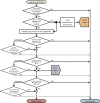A Workflow to Investigate Exposure and Pharmacokinetic Influences on High-Throughput in Vitro Chemical Screening Based on Adverse Outcome Pathways
- PMID: 25978103
- PMCID: PMC4710605
- DOI: 10.1289/ehp.1409450
A Workflow to Investigate Exposure and Pharmacokinetic Influences on High-Throughput in Vitro Chemical Screening Based on Adverse Outcome Pathways
Abstract
Background: Adverse outcome pathways (AOPs) link adverse effects in individuals or populations to a molecular initiating event (MIE) that can be quantified using in vitro methods. Practical application of AOPs in chemical-specific risk assessment requires incorporation of knowledge on exposure, along with absorption, distribution, metabolism, and excretion (ADME) properties of chemicals.
Objectives: We developed a conceptual workflow to examine exposure and ADME properties in relation to an MIE. The utility of this workflow was evaluated using a previously established AOP, acetylcholinesterase (AChE) inhibition.
Methods: Thirty chemicals found to inhibit human AChE in the ToxCast™ assay were examined with respect to their exposure, absorption potential, and ability to cross the blood-brain barrier (BBB). Structures of active chemicals were compared against structures of 1,029 inactive chemicals to detect possible parent compounds that might have active metabolites.
Results: Application of the workflow screened 10 "low-priority" chemicals of 30 active chemicals. Fifty-two of the 1,029 inactive chemicals exhibited a similarity threshold of ≥ 75% with their nearest active neighbors. Of these 52 compounds, 30 were excluded due to poor absorption or distribution. The remaining 22 compounds may inhibit AChE in vivo either directly or as a result of metabolic activation.
Conclusions: The incorporation of exposure and ADME properties into the conceptual workflow eliminated 10 "low-priority" chemicals that may otherwise have undergone additional, resource-consuming analyses. Our workflow also increased confidence in interpretation of in vitro results by identifying possible "false negatives."
Citation: Phillips MB, Leonard JA, Grulke CM, Chang DT, Edwards SW, Brooks R, Goldsmith MR, El-Masri H, Tan YM. 2016. A workflow to investigate exposure and pharmacokinetic influences on high-throughput in vitro chemical screening based on adverse outcome pathways. Environ Health Perspect 124:53-60; http://dx.doi.org/10.1289/ehp.1409450.
Conflict of interest statement
The U.S. EPA provided administrative review and approved this paper for publication. The views expressed in this paper are those of the authors and do not necessarily reflect the views of the U.S. EPA.
M.-R.G. and D.T.C. are employed by the Chemical Computing Group Inc., the publisher of the Molecular Operating Environment (MOE) software. The other authors declare they have no actual or potential competing financial interests.
Figures


Similar articles
-
Identification of acetylcholinesterase inhibitors using homogenous cell-based assays in quantitative high-throughput screening platforms.Biotechnol J. 2017 May;12(5). doi: 10.1002/biot.201600715. Epub 2017 Apr 6. Biotechnol J. 2017. PMID: 28294544
-
Consideration of dosimetry in evaluation of ToxCast™ data.J Appl Toxicol. 2011 Nov;31(8):741-51. doi: 10.1002/jat.1626. Epub 2011 Mar 5. J Appl Toxicol. 2011. PMID: 21381051
-
Prioritizing Environmental Chemicals for Obesity and Diabetes Outcomes Research: A Screening Approach Using ToxCast™ High-Throughput Data.Environ Health Perspect. 2016 Aug;124(8):1141-54. doi: 10.1289/ehp.1510456. Epub 2016 Mar 15. Environ Health Perspect. 2016. PMID: 26978842 Free PMC article.
-
Development of an adverse outcome pathway for acetylcholinesterase inhibition leading to acute mortality.Environ Toxicol Chem. 2014 Oct;33(10):2157-69. doi: 10.1002/etc.2662. Epub 2014 Aug 25. Environ Toxicol Chem. 2014. PMID: 24922588 Review.
-
The Next Generation of Risk Assessment Multi-Year Study-Highlights of Findings, Applications to Risk Assessment, and Future Directions.Environ Health Perspect. 2016 Nov;124(11):1671-1682. doi: 10.1289/EHP233. Epub 2016 Apr 19. Environ Health Perspect. 2016. PMID: 27091369 Free PMC article. Review.
Cited by
-
From the exposome to mechanistic understanding of chemical-induced adverse effects.Environ Int. 2017 Feb;99:97-106. doi: 10.1016/j.envint.2016.11.029. Epub 2016 Dec 8. Environ Int. 2017. PMID: 27939949 Free PMC article. Review.
-
Estimating Margin of Exposure to Thyroid Peroxidase Inhibitors Using High-Throughput in vitro Data, High-Throughput Exposure Modeling, and Physiologically Based Pharmacokinetic/Pharmacodynamic Modeling.Toxicol Sci. 2016 May;151(1):57-70. doi: 10.1093/toxsci/kfw022. Epub 2016 Feb 10. Toxicol Sci. 2016. PMID: 26865668 Free PMC article.
-
Drug Metabolism in Preclinical Drug Development: A Survey of the Discovery Process, Toxicology, and Computational Tools.Curr Drug Metab. 2017;18(6):556-565. doi: 10.2174/1389200218666170316093301. Curr Drug Metab. 2017. PMID: 28302026 Free PMC article. Review.
-
Evaluating the Impact of Uncertainties in Clearance and Exposure When Prioritizing Chemicals Screened in High-Throughput Assays.Environ Sci Technol. 2016 Jun 7;50(11):5961-71. doi: 10.1021/acs.est.6b00374. Epub 2016 May 12. Environ Sci Technol. 2016. PMID: 27124219 Free PMC article.
-
Designing QSARs for Parameters of High-Throughput Toxicokinetic Models Using Open-Source Descriptors.Environ Sci Technol. 2021 May 4;55(9):6505-6517. doi: 10.1021/acs.est.0c06117. Epub 2021 Apr 15. Environ Sci Technol. 2021. PMID: 33856768 Free PMC article.
References
-
- Abass K, Reponen P, Mattila S, Pelkonen O. Metabolism of carbosulfan II. Human interindividual variability in its in vitro hepatic biotransformation and the identification of the cytochrome p450 isoforms involved. Chem Biol Interact. 2010;185:163–173. - PubMed
-
- Ankley GT, Bennett RS, Erickson RJ, Hoff DJ, Hornung MW, Johnson RD, et al. Adverse outcome pathways: a conceptual framework to support ecotoxicology research and risk assessment. Environ Toxicol Chem. 2010;29:730–741. - PubMed
-
- Baell JB, Holloway GA. New substructure filters for removal of pan assay interference compounds (PAINS) from screening libraries and for their exclusion in bioassays. J Med Chem. 2010;53:2719–2740. - PubMed
-
- Baell J, Walters MA. Chemistry: chemical con artists foil drug discovery. Nature. 2014;513:481–483. - PubMed
Publication types
MeSH terms
Substances
LinkOut - more resources
Full Text Sources
Other Literature Sources
Miscellaneous

